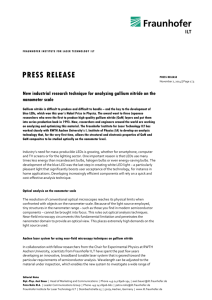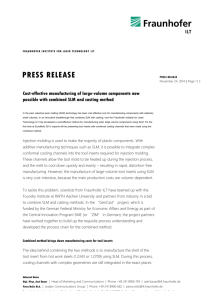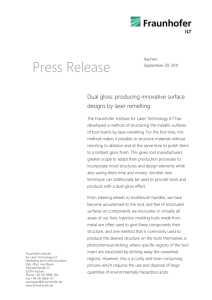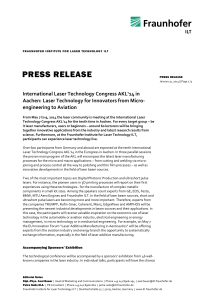DOCX 0.06 MB
advertisement
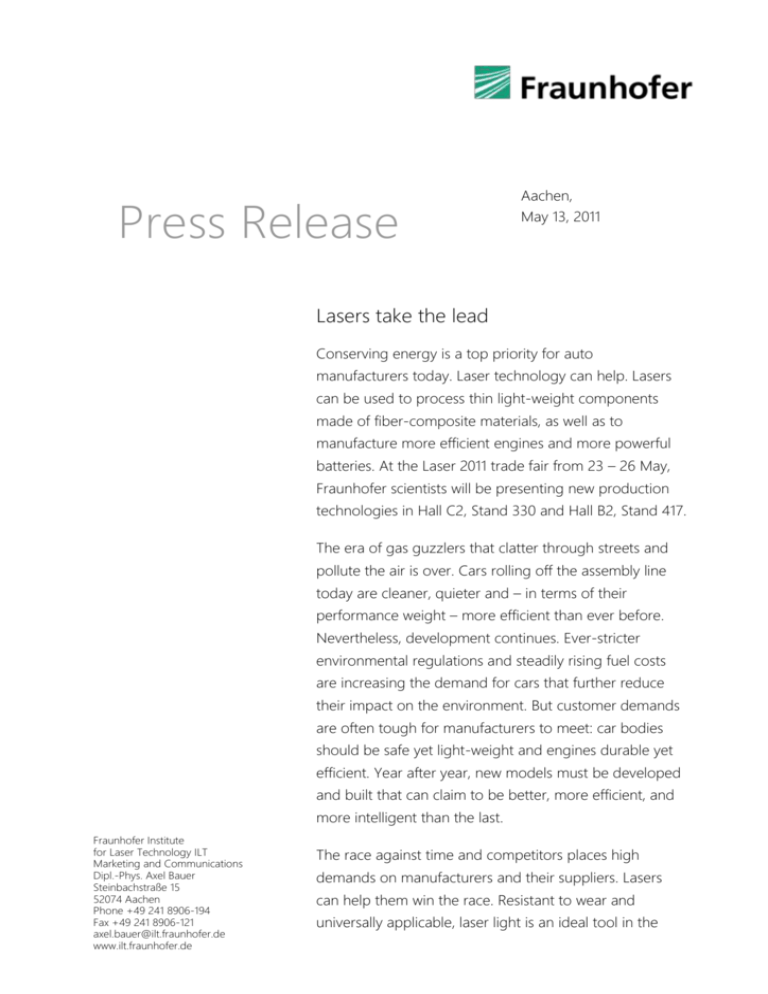
Press Release Aachen, May 13, 2011 Lasers take the lead Conserving energy is a top priority for auto manufacturers today. Laser technology can help. Lasers can be used to process thin light-weight components made of fiber-composite materials, as well as to manufacture more efficient engines and more powerful batteries. At the Laser 2011 trade fair from 23 – 26 May, Fraunhofer scientists will be presenting new production technologies in Hall C2, Stand 330 and Hall B2, Stand 417. The era of gas guzzlers that clatter through streets and pollute the air is over. Cars rolling off the assembly line today are cleaner, quieter and – in terms of their performance weight – more efficient than ever before. Nevertheless, development continues. Ever-stricter environmental regulations and steadily rising fuel costs are increasing the demand for cars that further reduce their impact on the environment. But customer demands are often tough for manufacturers to meet: car bodies should be safe yet light-weight and engines durable yet efficient. Year after year, new models must be developed and built that can claim to be better, more efficient, and more intelligent than the last. Fraunhofer Institute for Laser Technology ILT Marketing and Communications Dipl.-Phys. Axel Bauer Steinbachstraße 15 52074 Aachen Phone +49 241 8906-194 Fax +49 241 8906-121 axel.bauer@ilt.fraunhofer.de www.ilt.fraunhofer.de The race against time and competitors places high demands on manufacturers and their suppliers. Lasers can help them win the race. Resistant to wear and universally applicable, laser light is an ideal tool in the May 13, 2011 Page 2 manufacture of vehicles. Lasers can be used to join, drill, structure, cut or shape any kind of material. Surfaces can be engineered for motors and drive trains that create less friction and use less fuel. Lasers are not only a decisive key towards faster, more efficient and economical production, but also towards energy-saving vehicles. At Laser 2011, Fraunhofer scientists will demonstrate how we can use lasers to save time, money and energy. Fraunhofer Institute for Laser Technology ILT Marketing and Communications Dipl.-Phys. Axel Bauer Steinbachstraße 15 52074 Aachen Phone +49 241 8906-194 Fax +49 241 8906-121 axel.bauer@ilt.fraunhofer.de www.ilt.fraunhofer.de May 13, 2011 Page 3 A weight-loss program in automotive manufacturing Extra pounds cost energy. They have to be accelerated and slowed down every time you drive – over the entire lifespan of the car. To reduce weight, manufacturers are increasingly turning to the use of fiber-reinforced plastics, which are 30 to 50 percent lighter than metal. The disadvantage, however, is that these new materials are difficult to process. Fiber-reinforced plastics are brittle, meaning cutting and drilling tools are quickly worn out and the conventional assembly techniques used for metal components are often not appropriate. “Lasers represent an ideal alternative here,” explains Dr. Arnold Gillner of the Fraunhofer Institute for Laser Technology ILT in Aachen. “Lasers can cut fiber-reinforced plastics without wear and can join them too. With the appropriate lasers, we can cut and ablate components with minimal thermal side-effects. Lasers can also be used for welding light-weight components – a viable alternative to conventional bonding technology. We can even join fiber-reinforced plastics to metals with laser welding. The laser roughens the metal surface, while the plastic, brieflyheated, penetrates the pores of the metal and hardens. The results are very stable.” Fraunhofer Institute for Laser Technology ILT Marketing and Communications Dipl.-Phys. Axel Bauer Steinbachstraße 15 52074 Aachen Phone +49 241 8906-194 Fax +49 241 8906-121 axel.bauer@ilt.fraunhofer.de www.ilt.fraunhofer.de Weight reduction can also be achieved with highstrength metallic materials. These, however, are difficult to process. “Joining combinations of various materials allows us to make optimal use of the individual May 13, 2011 Page 4 materials’ specific properties. But this proves to be difficult in many cases,” explains Dr. Anja Techel, Deputy Director of the Fraunhofer Institute for Material and Beam Technology IWS in Dresden. Her team believes in lasers: “With our newly-developed integrated laser tools, we can now even weld together combinations of materials, free of fissures or cracks.” At Laser 2011, Fraunhofer scientists will present, for the first time, a new welding head capable not only of focusing with extreme precision but of moving back and forth across the seam with high frequency to mix the molten materials. When they harden, they create a stable bond. Fraunhofer Institute for Laser Technology ILT Marketing and Communications Dipl.-Phys. Axel Bauer Steinbachstraße 15 52074 Aachen Phone +49 241 8906-194 Fax +49 241 8906-121 axel.bauer@ilt.fraunhofer.de www.ilt.fraunhofer.de May 13, 2011 Page 5 Laser replaces chemistry Lasers also save time and money in tool design. The molds used in the production of plastic fixtures and steering wheels, for example, have to be structured to give the finished component a visually and tactilely appealing surface. Most car manufacturers order a design from their suppliers, whose surface typically has the appearance of leather. Until now, the negative pattern used to create the design has been etched out of the steel tools used in injection molding – a tedious and time-consuming process. “With lasers, the steel surface can not only be patterned more quickly, but also with greater scope for variety,” explains Kristian Arntz of the Fraunhofer Institute for Production Technology IPT. “We can transfer any possible design directly from the CAD model to the tool surface: What will later become a groove in the plastic is preserved as a ridge, while the surrounding material is vaporized. The process is efficient, fully automatic, and highly variable.” Saving energy with low friction motors Laser technology is also in demand in engine Fraunhofer Institute for Laser Technology ILT Marketing and Communications Dipl.-Phys. Axel Bauer Steinbachstraße 15 52074 Aachen Phone +49 241 8906-194 Fax +49 241 8906-121 axel.bauer@ilt.fraunhofer.de www.ilt.fraunhofer.de optimization. Engineers strive to keep friction as low as possible in order to improve efficiency. “That is true not only for the electric engines currently being developed, but also for classic internal combustion engines and diesel motors, as well as transmissions and bearings,” May 13, 2011 Page 6 says Arnold Gillner of the ILT. Ceramic, high-performance coatings are especially desirable, because they are not only resistant to wear but also smooth, which generates less friction. Coated metal components have until now been prohibitively expensive, being produced in plasma chambers in which the ceramic was vaporized and applied to the surface of the components. Fraunhofer scientists have now developed a less expensive and faster method in which work pieces are coated with ceramic nano-particles, then treated with a laser. This finishing process has already been applied to gear wheels and bearings. Lasers can even be used to make specific modifications to the properties of engine parts. “Friction between the cylinder wall and piston is responsible for a big part of a motor’s energy consumption. That is why we try to minimize it. This is especially important for engines featuring modern, automatic start-stop functions that are stressed by frequent ignition,” says Gillner. “To protect them, we have to ensure that the cylinder is always coated with a film of oil. Laser technology can help reduce friction with special structuring processes that improve oil adhesion.” Fraunhofer researchers aim to Fraunhofer Institute for Laser Technology ILT Marketing and Communications Dipl.-Phys. Axel Bauer Steinbachstraße 15 52074 Aachen Phone +49 241 8906-194 Fax +49 241 8906-121 axel.bauer@ilt.fraunhofer.de www.ilt.fraunhofer.de increase the engine’s life-span and reduce energy consumption in this way. Fitness program for electric cars May 13, 2011 Page 7 Lasers can even increase the efficiency and life-span of electric batteries. That is good news for manufacturers and owners of electric cars, since batteries continue to be extremely expensive. The engineers and scientists at Fraunhofer are currently working on various solutions to make batteries more durable and less expensive. One approach is to increase the surface area of the electrodes with appropriate coating in order to increase their efficiency. Another approach involves analyzing and optimizing production processes. Manufacturers produce batteries using one anode and one cathode cell, which they then connect. In theory that sounds pretty simple, but in practice the fusing of copper anodes with aluminum cathodes creates brittle connections that break easily. That presents a problem for application in cars that sometimes drive on cobblestone or dirt roads. With the help of lasers, researchers at the ILT have succeeded in forming durable connections between electrodes without creating the culprit brittle alloys. Researchers at the IWS in Dresden have developed an alternative solution in which a laser warms the surfaces and rollers press them together. “Using roll plating with lasers and inductive pre-heating, we were able to create very stable Fraunhofer Institute for Laser Technology ILT Marketing and Communications Dipl.-Phys. Axel Bauer Steinbachstraße 15 52074 Aachen Phone +49 241 8906-194 Fax +49 241 8906-121 axel.bauer@ilt.fraunhofer.de www.ilt.fraunhofer.de connections with high electrical conductivity, with only a minimal loss of power,” reports Anja Techel. “The finished batteries are very efficient. And since only small amounts of electrical energy are transformed into heat, these batteries do not require as much cooling.” May 13, 2011 Page 8 Captions: Figure 1: The welding of aluminum and copper battery lugs with a disk laser for the production of battery systems used in electric vehicles. (© Fraunhofer ILT) Contacts at the Fraunhofer Institutes If you have any questions regarding this topic, please feel free to contact our experts: Dr.-Ing. Arnold Gillner Fraunhofer Institute for Laser Technology ILT Phone +49 241 8906-148 arnold.gillner@ilt.fraunhofer.de Dr.-Ing. Anja Techel Fraunhofer Institute for Material and Beam Technology IWS Phone +49 351 83391-3473 anja.techel@iws.fraunhofer.de Dipl.-Ing. Kristian Arntz Fraunhofer Institute for Production Technology IPT Phone +49 241 8904-121 kristian.arntz@ipt.fraunhofer.de Fraunhofer Institute for Laser Technology ILT Marketing and Communications Dipl.-Phys. Axel Bauer Steinbachstraße 15 52074 Aachen Phone +49 241 8906-194 Fax +49 241 8906-121 axel.bauer@ilt.fraunhofer.de www.ilt.fraunhofer.de
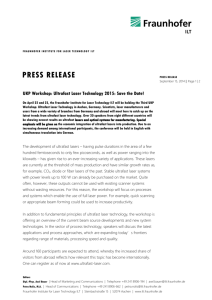
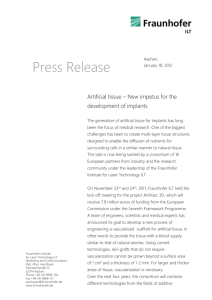
![Scalable SLM machine design [ DOCX 0.15 MB ]](http://s3.studylib.net/store/data/006980860_1-a3d8729653f9ce51e6e3d7d4cce3f10e-300x300.png)
![LASHARE Press Release Project Start [ DOCX 0.29 MB ]](http://s3.studylib.net/store/data/006895368_2-c419881f96c28d1378c5ef51519b8fdb-300x300.png)
